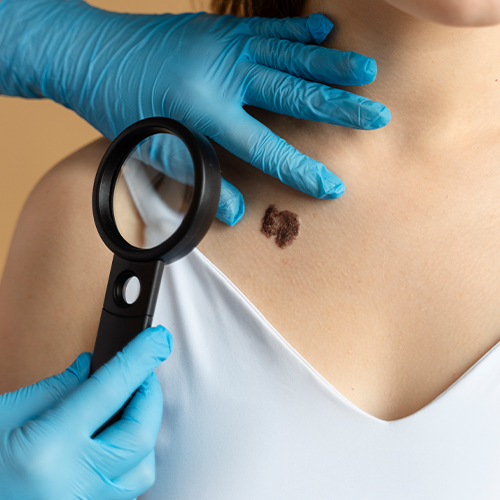Skin Cancers
Skin Cancers
Skin cancers are among the most common types of cancer, caused by the uncontrolled growth of skin cells. We can say that they are the most easily preventable but also the most neglected cancers. Apart from malignant melanoma, which is one of the most feared cancers, skin cancers generally have a good prognosis and respond well to treatments. Malignant melanoma, however, has changed in recent years with new drugs, making it a disease that we can now treat more effectively.
Symptoms:
- Moles and freckles on the skin.
- A wound that doesn’t heal.
- Noticeable changes on the skin surface.
- Redness, tenderness, or newly developed swelling.
- Any changes in the color, size, surface, or bleeding of a mole on the body.
Self-examination is important not only for breast cancer but also for skin cancer!
Taking just five minutes once a month to examine all visible parts of your body can be beneficial. Regularly observing your skin in the mirror and even taking selfies with your phone to track skin changes may save more lives than we expect. If you have many freckles, moles, or other lesions on your body, periodic dermatological check-ups may also be necessary. A dermoscopy examination by a dermatologist will provide much more information about the structure of lesions.
The most common types of skin cancer:
- Basal cell carcinoma
- Squamous cell carcinoma
- Malignant melanoma
Basal and squamous cell carcinomas are typically found on areas more exposed to the sun, like the face and hands, whereas malignant melanoma is more commonly seen on areas not related to sun exposure, such as the back, limbs, or even nails.
Malignant melanoma accounts for 1% of all skin cancers, but if not treated early before it spreads to lymph nodes, it can be more aggressive. Therefore, early detection of malignant melanoma is crucial. Between 1970 and 2009, the incidence of melanoma increased by 800% among women aged 18-39, primarily due to a passion for sunbathing and tanning. Melanoma is typically black or purple but can also appear in lighter colors.
Causes:
- Sun exposure: Continuous exposure to the sun and UV rays can cause DNA damage in skin cells, leading to mutations and eventually cancer. About 90% of skin cancers are caused by sun exposure. Sun exposure is not limited to beach vacations; significant exposure also occurs during activities like skiing.
- Genetics: Especially significant in malignant melanoma.
- Fair skin: Having fair skin increases the risk, but studies have shown that melanoma is more aggressive in darker-skinned individuals.
- Certain immune system diseases: Conditions like lupus, Crohn’s disease, or rheumatoid arthritis can make the skin more susceptible. Additionally, immunosuppressive drugs used to treat these diseases can further increase the risk.
- Alcohol: Alcohol increases skin sensitivity to the sun. A study found that consuming more than four cocktails or several strong beers per day increases the risk of melanoma by 55%.
- Previous injuries: Skin that has experienced trauma, like burns or radiation therapy, may develop squamous cell cancer.
- Chemicals: Prolonged exposure to chemicals such as creosote and arsenic can lead to skin cancer.
- Citrus fruits: A study found that people who drink at least one glass of orange juice daily have a 36% higher risk of developing skin cancer compared to those who drink it less than twice a week. It is recommended not to go into the sun for a few hours after consuming these fruits.
Prevention:
- Control your sun exposure times. For vitamin D synthesis, being in the sun between 10:00 AM and 4:00 PM is sufficient, but this time should be limited.
- Do not use expired cosmetic products.
- Avoid tanning beds.
- Wear UV-filtering sunglasses to protect your eyes from skin cancer. Avoid small glasses that are fashionable; instead, ensure they fully cover your eyes and the surrounding area.
- Using daily sunscreen with at least SPF 15 reduces the risk of squamous cell carcinoma by 40% and melanoma by 50%. The SPF level is a debated topic, but the American Academy of Dermatology recommends using sunscreen with at least SPF 30. Remember to apply sunscreen to children as well.
Common misconceptions about sunscreen:
- Dark-skinned people need less sunscreen.
- Only external skin needs protection; areas like the lips and ears don’t.
- Sunscreen is only necessary when going outdoors.
- The higher the SPF, the longer you can stay in the sun.
- Applying once a day is enough.
- It only needs to be applied during sunny periods of the year.
- Expiration dates on products don’t matter.
- Spray sunscreens are more effective.
- Sunscreen is more effective after swimming or wearing clothes.
- All sunscreens are the same.
- The most expensive product is the best.
- Lower SPF is better.
- Broad-spectrum creams are not always necessary.
- Moisturizers or cosmetics with SPF are sufficient.
- Summer clothing blocks enough UV rays.
Treatment: Lesions that have the potential to become cancerous are called actinic keratoses. Procedures like freezing with liquid nitrogen or curettage to remove them from the skin are usually sufficient. When cancer develops, the size, spread, type, and overall condition of the patient are important factors in determining the treatment.
Surgical treatment is usually sufficient for non-melanoma skin cancers. However, the tumor must be removed along with the surrounding healthy tissue. In cases where the tumor cannot be surgically removed due to its location or the patient’s condition, radiotherapy is an option. For superficial skin cancers, topical chemotherapy in the form of creams or lotions may also be an option.
The treatment of malignant melanoma is more complex. After removing the lesion, depending on its pathological characteristics, radiotherapy, chemotherapy, or immunotherapy may be appropriate. It is important to remember that staging the disease, or imaging the entire body, is necessary before starting treatment.








